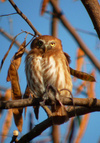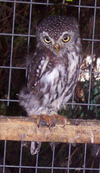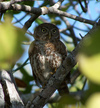Genus Glaucidium

Prigogine's Owlet - The Albertine Owlet, Glaucidium albertinum, is a species of owl in the Strigidae family. It is found in Democratic Republic of the Congo and Rwanda. Its natural habitat is subtropical or tropical moist montanes. It is threatened by habitat loss.
Ferruginous Pygmy Owl - This species is a part of the larger grouping of owls known as typical owls, Strigidae, the family that contains most species of owl. The other grouping is the barn owls, Tytonidae.
African Barred Owlet - The species is most frequently found in woodland and forests, and on forest edges. It may also occur in more open savannah and along rivers. It is partly diurnal, and feeds mostly on insects, although small rodents and birds may also be eaten.
Ituri Owlet - The Chestnut Owlet is a species of owl in the Strigidae family. It is found in Cameroon, Democratic Republic of the Congo, Ivory Coast, Liberia, and Uganda.
Chestnut-backed Owlet - The Chestnut-backed Owlet is small and stocky. It resembles the Jungle Owlet in shape, size and appearance but the upperparts, scapulars and wing coverts are mainly chestnut brown, with darker barring. The underparts are white with blackish shaft-streaks. The facial disc is mainly brown and the eyes are yellow. There is a white neckband. Sexes are similar. There is no sexual dimorphism
Javan Owlet - Its natural habitat is subtropical or tropical moist lowland forests.
Costa Rican Pygmy-Owl - The Costa Rican Pygmy-owl is a species of owl in the Strigidae family. It is found in Costa Rica and Panama.
Asian Barred Owlet - at Jayanti in Buxa Tiger Reserve in Jalpaiguri district of West Bengal, India.
California pygmy owl - Some experts consider this bird a superspecies with the Mountain Pygmy Owl. The American Ornithologists' Union, the authority for the North American region, does not recognize this split, so the populations are still considered conspecific. Clear differences in the territorial calls by males are the basis for a proposed split, with birds in the high elevations of Arizona and Mexico giving a two-note call while their more northerly congeners give a repeated single-note call. Results from DNA sequence comparisons of cytochrome-b have been weak and inconclusive despite being referenced repeatedly as a justification for taxonomic splitting.
Central American Pygmy-Owl - It is found in Belize, Colombia, Costa Rica, Ecuador, Guatemala, Honduras, Mexico, Nicaragua, and Panama.
Amazonian Pygmy-Owl - The Amazonian Pygmy-owl Glaucidium hardyi is an owl found in northern South America and northern Brazil, in the center of the Amazon Basin, and in Venezuela and the Guianas. In the southwest of the basin bordering the Andes cordillera, the species is found in Peru, and Bolivia. In the Guyanas, the range is bifurcated, as the species is not found in the middle country of Suriname.
Andean Pygmy Owl - Its natural habitat is subtropical or tropical moist montane forests.
Least Pygmy-Owl - The Least Pygmy-owl , also known as Sick's Pygmy-owl, is a small owl in the typical owl family. It has been argued that the here used scientific name actually belongs to the Pernambuco Pygmy-owl, in which case the Least Pygmy-owl should be referred to G. sicki .
Pernambuco Pygmy-owl - This owl is classified as critically endangered by BirdLife International. It is assumed to have a tiny and declining population within an extremely small known range. The population is estimated at less than fifty adult birds.
Austral Pygmy Owl - Its natural habitat is temperate forests.
Cloud-forest pygmy-owl - Its natural habitat is subtropical or tropical moist montane forests. It is threatened by habitat loss.
Colima Pygmy-Owl - The Colima Pygmy-owl is a species of owl in the Strigidae family. It is endemic to Mexico.
Pygmy Owl - The owl preys on birds – some nearly as large as itself – and small mammals, such as voles.
Pearl-spotted Owlet - Pearl-spotted Owlet is a common and easily seen bird in open woodland and savannah. It nests in a hole in a tree, such as a disused barbet nest, laying 2-4 eggs.
Peruvian Pygmy-Owl - The Peruvian Pygmy-owl is a species of owl in the Strigidae family. It is found in Ecuador and Peru. Its natural habitats are subtropical or tropical dry shrubland, subtropical or tropical moist shrubland, subtropical or tropical high-altitude shrubland, and heavily degraded former forest.
Jungle Owlet - The Jungle Owlet or Barred Jungle Owlet, Glaucidium radiatum, is found in India and the dry zone of Sri Lanka. The species is often found singly, in pairs or small groups and are usually detected by their calls at dawn and dusk. There are two subspecies with the form found in the Western Ghats sometimes considered a full species.
Tamaulipas Pygmy-Owl - Its natural habitat is subtropical or tropical moist montanes.
Cuban Pygmy Owl - The Cuban Pygmy-owl is a species of owl in the Strigidae family that is endemic to Cuba. Its natural habitats are dry forests, moist forests, and heavily degraded former forest.




